Real leather does not peel nor flake. The only exception is if a leather’s urethane finish has been damaged. In this case, you’ll notice the grain and texture remain intact, and it’s easily corrected. See here.
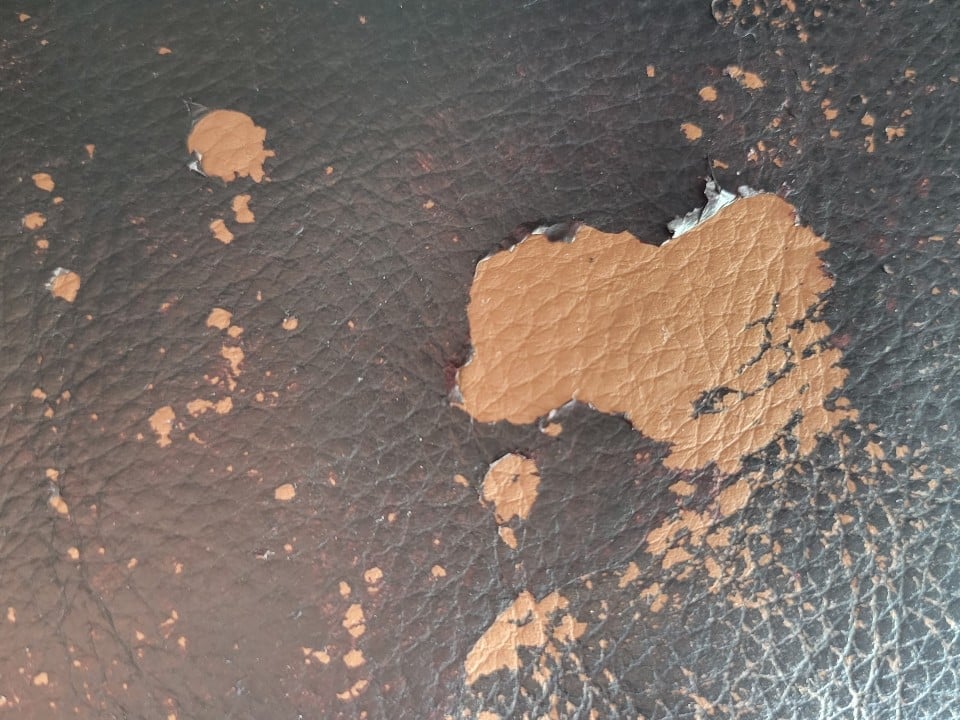
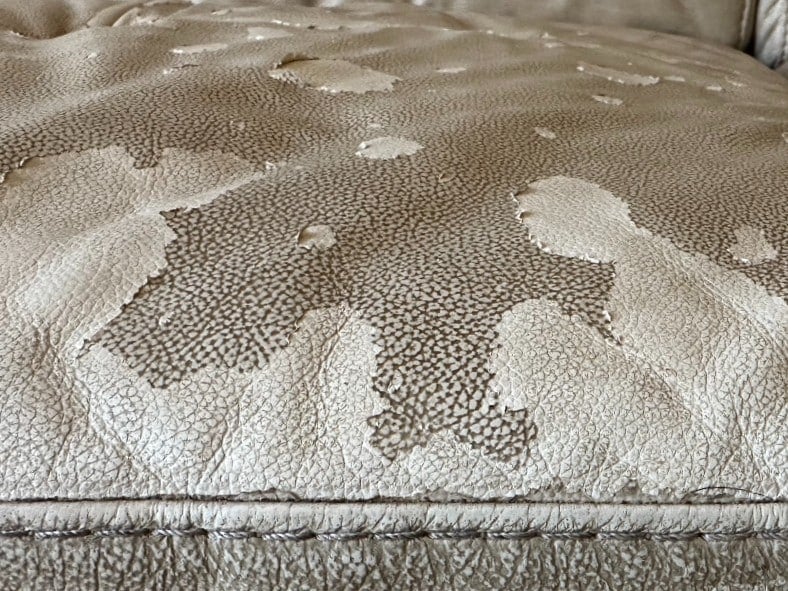
More often, peeling is a sign of fake leather whose polyurethane (PU) coating has begun to delaminate from the underlying fabric.
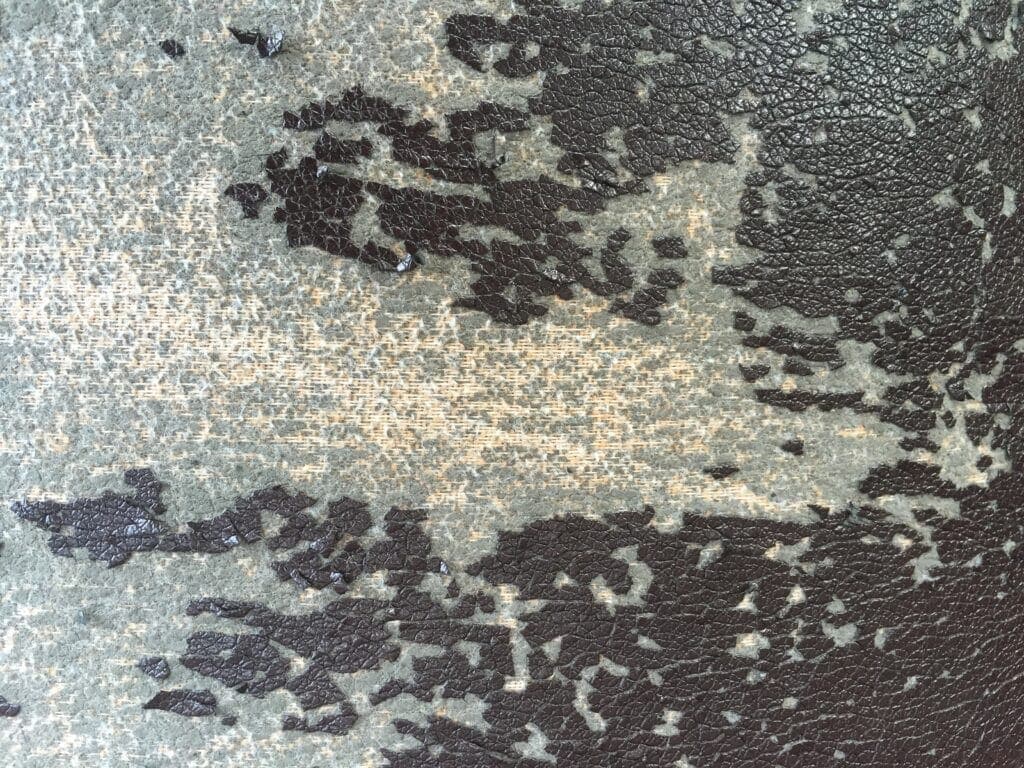
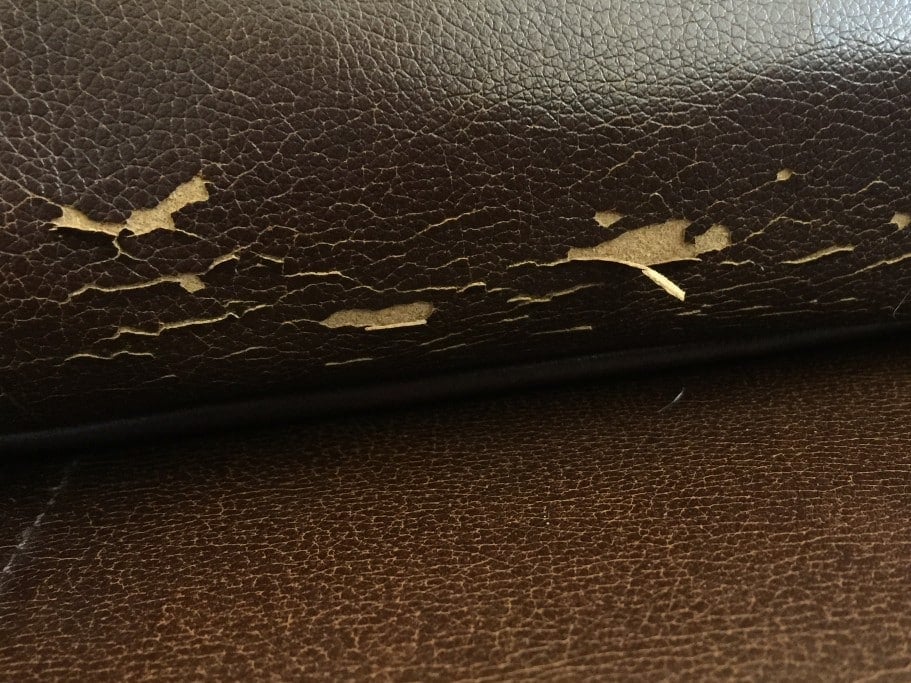
There’s nothing that can be done to prevent or protect it, and repairs seldom last. Changing color is definitely not a consideration. How you fix it, why it won’t hold up, and affordable options are below. But first a little background.
What are bonded and faux leather?
Bonded leather (also called blended or reconstituted leather) is a composite material made of 10-20% ground scrap leather coated with a polyurethane ‘skin’. DuraBlend® and EnviroBlend® are US trademarked names for bonded leather.
Faux (the French word for ‘fake’) and vegan leather are rayon or polyester fabric coated with polyurethane ‘skin’. They are 100% synthetic. Ultraleather® is a trademarked brand of faux leather.
These materials are the equivalent of cheap particle board and are not to be confused with better quality vinyl (PVC), which is widely used in boat, auto, and furniture upholstery.
Vinyl is very toxic to produce, however. Polyurethane-coated artificial leathers were developed in response.
Unfortunately, these polyurethane coatings often develop hairline cracks and delaminate in as little as 18 months — just as the warranty has expired. This is known as ‘hydrolysis-related failure’ by the industry and is specifically excluded from many warranty policies.
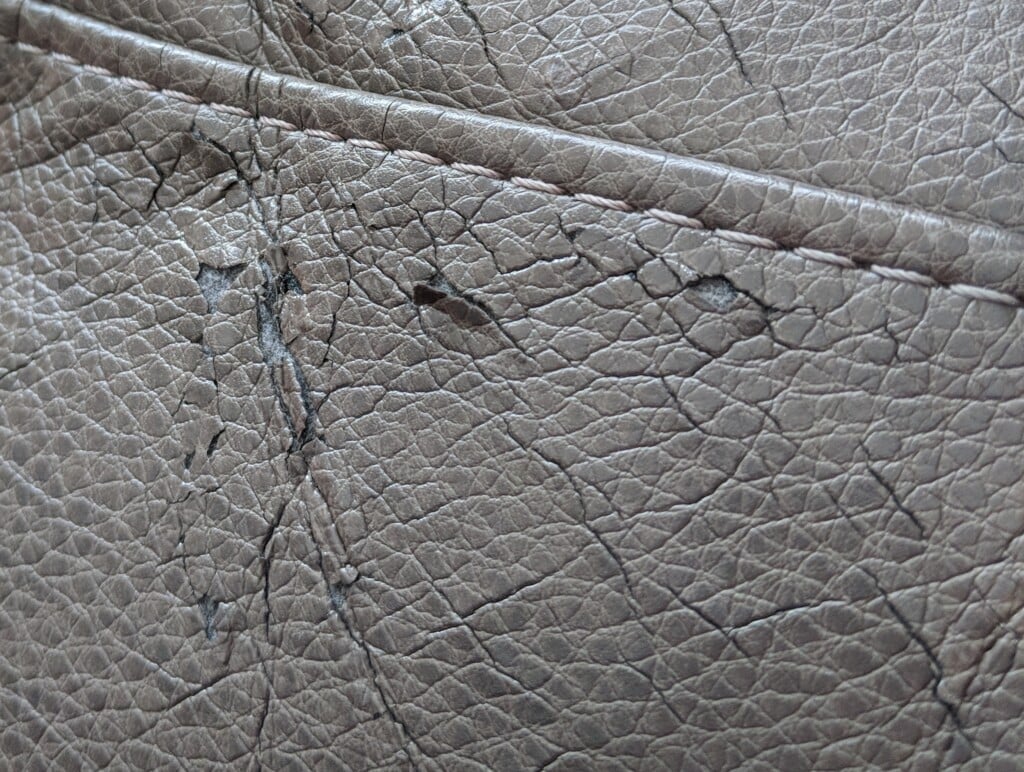
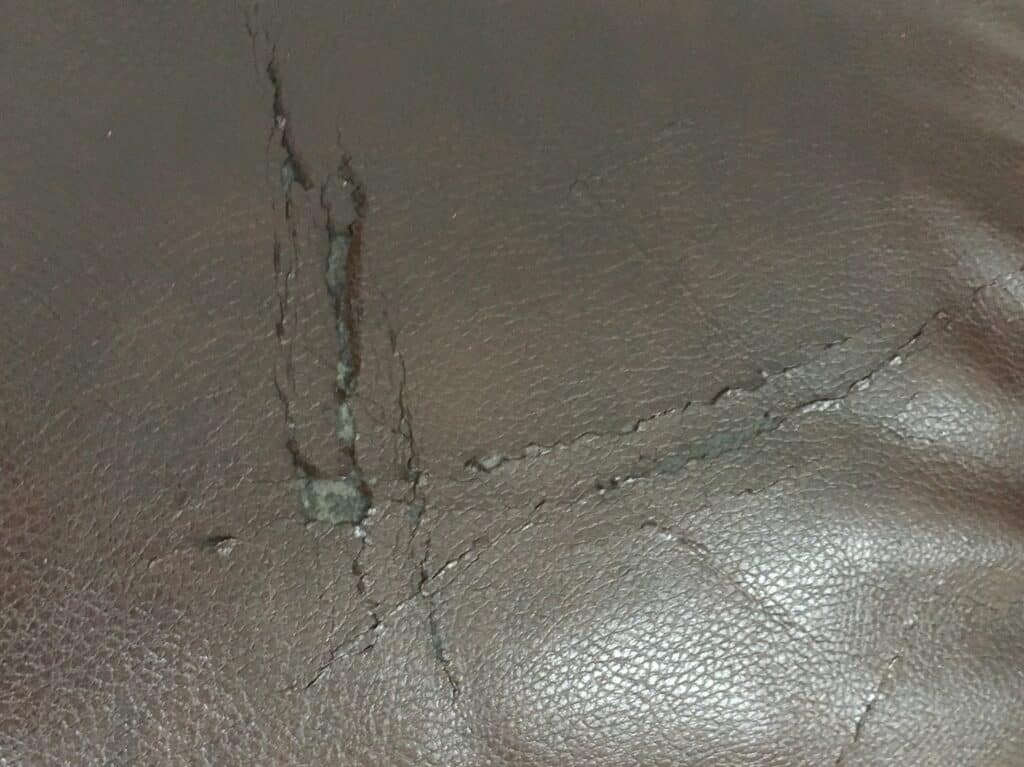
The industry uses ISO 1419 Tropical Test Method C (nicknamed the Jungle Test) to assess a material’s ‘hydrolysis resistance’, or rather, if and when a bonded or faux leather will crack, peel or delaminate in hot, humid conditions. The Association for Contract Textiles’ guideline recommends a minimum 5 week rating. “Note that there is no direct correlation of testing weeks to years of service in the field.” Even the best polyurethane resins for commercial use were never expected to last more than a few years.
What toxic pollution was spared by producing polyurethane leather instead of vinyl is neutered by their disposability and profusion in landfills.
Why are consumers misled about faux and bonded leather?
Most folks — consumers and salespeople alike — don’t know how to tell the difference between real and artificial leathers and often assume it’s real simply because ‘leather’ appears somewhere in the description. It wasn’t until 2017 that the term ‘leather’ came to be regulated in the United States.
Still, ignorance and affordability allow these inferior fake leathers to prevail.
Even at a wholesale price, top grain leather costs about $100 / yard. Full grain costs even more, and it takes many yards to upholster a piece of furniture:
- large club chair: 5-7 yards = $500-$700 leather cost
- 3-seat couch: 15-20 yards = $1,500-$2,000 leather cost
- 5 or 6-seat sectional: 30 yards = $3,000 leather cost
These figures don’t include other materials like the wood or metal frame, foam stuffing, nor the labor. Do the math. If you paid $1,500-$2,000 for a new leather couch, it is likely fake.
There’s no product that can stop ‘leather’ from peeling.
The instability of bonded and faux leather means new coatings don’t adhere well. As such, repairs don’t last and are discouraged. The video in option 2 below demonstrates how you’d repair it, and why we can’t, in good conscience, recommend it.
Ask yourself: do you want to spend time and money to improve its appearance, knowing such an improvement may be short-lived and likely a waste (option 1 and option 2)? Or would you rather invest a similar amount of time and money in a better-quality piece that will last years, even decades (option 3)?
Option 1: Stain the Fabric
Peel and scrape away all the unstable polyurethane ‘skin’, and stain the exposed fabric with one of our water-based paints.
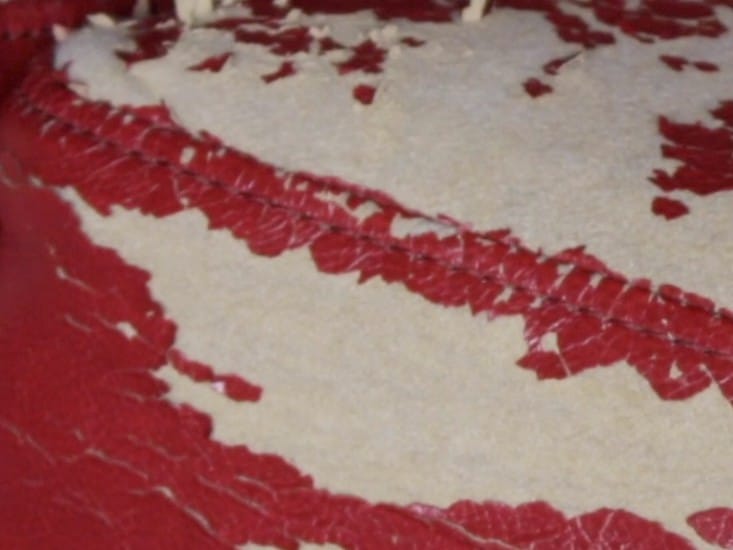
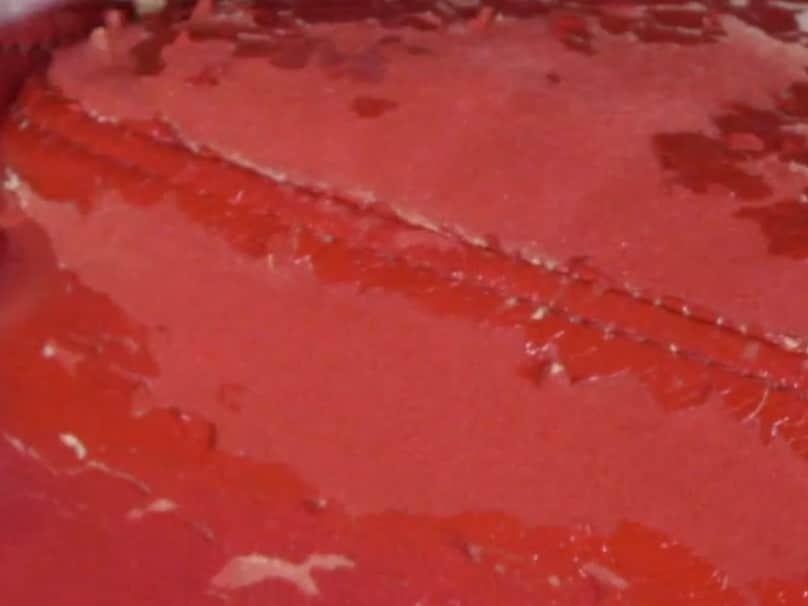
This will take a couple hours and cost $23 – $50, depending on the scope of the damage. This improves appearance somewhat, but you will not have a smooth, lustrous leather-like surface that repels water, and the disparity in texture will be obvious up close.
Option 2: Peel, Repair, Recolor
Resurface the exposed fabric using a leather filler putty or rubberized coating, followed by color, as demonstrated in the video below. You’ll spend several hours peeling, resurfacing, and recoloring. The cost will range from $41 to upwards of $100. There’s no guarantee the repairs will hold up, and the piece will continue to degrade elsewhere.
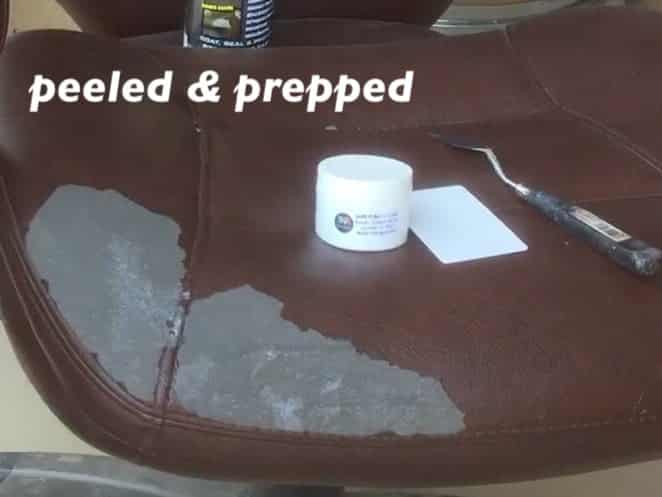
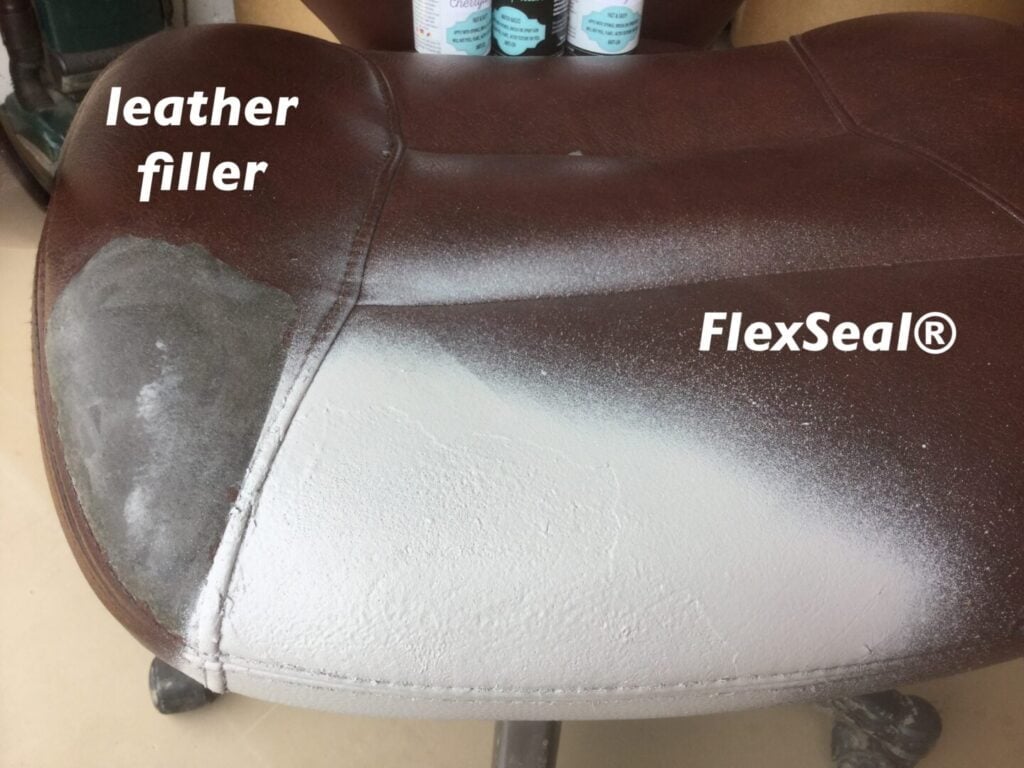
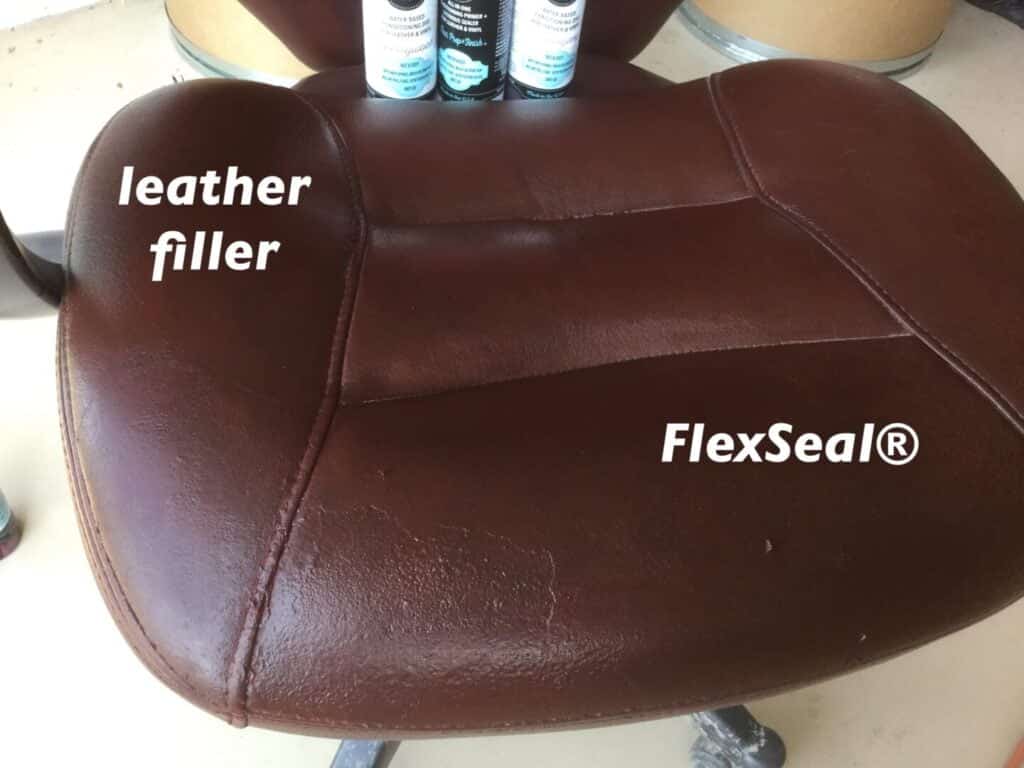
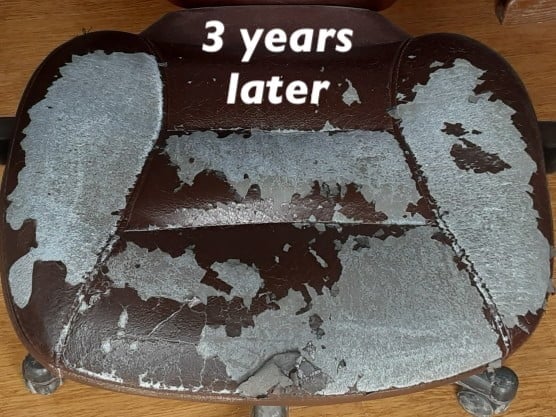
- 0:00 – Intro
- 0:28 – Prep peeling
- 0:57 – Applying Soft Filler leather repair putty
- 3:47 – Alas, more peeling
- 3:58 – Applying FlexSeal® rubber paint
- 5:13 – Comparing Soft Filler to FlexSeal®
- 5:45 – Recoloring
- 6:22 – The final result
- 6:40 – The verdict after a month of use
- 7:19 – Our recommendation
Option 3: Cut the Loss & Invest in Something Better
Replace the piece with real, good-quality leather, and restore it or even change the color. It’s amazing how many fine quality pieces can be found on Facebook Marketplace and Craigslist for just a couple hundreds dollars, if not for free. Don’t be afraid of stains, fading or even a hole. These are easily repaired with the same — if not less — effort than that of option 2. The cost may be as little as $23. Even if you need lots of repair materials and spring for color matching on a huge sectional, you won’t spend more than $250 – $300. Such an investment is worthy of a piece that cost several thousand dollars new and will last decades.
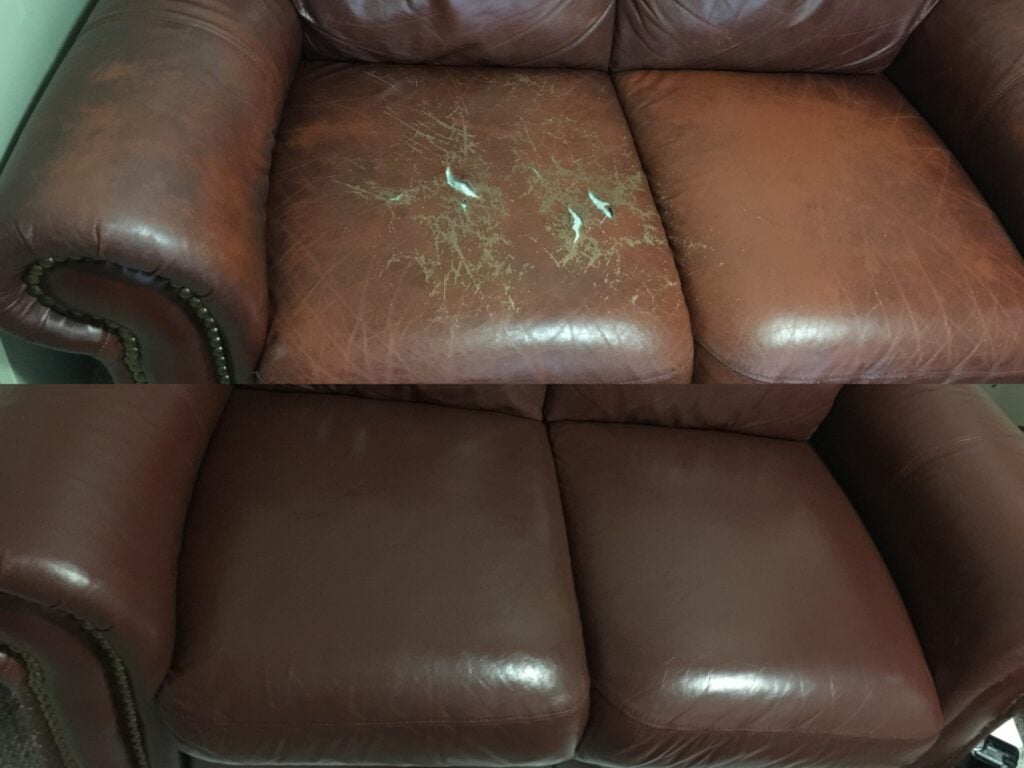

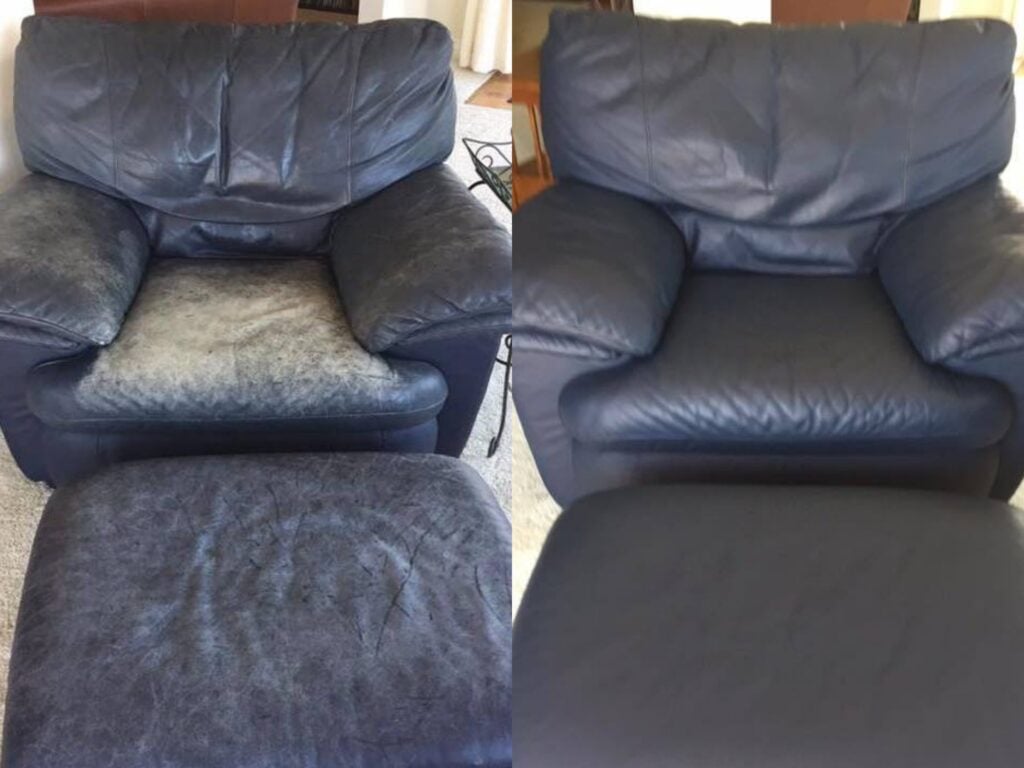
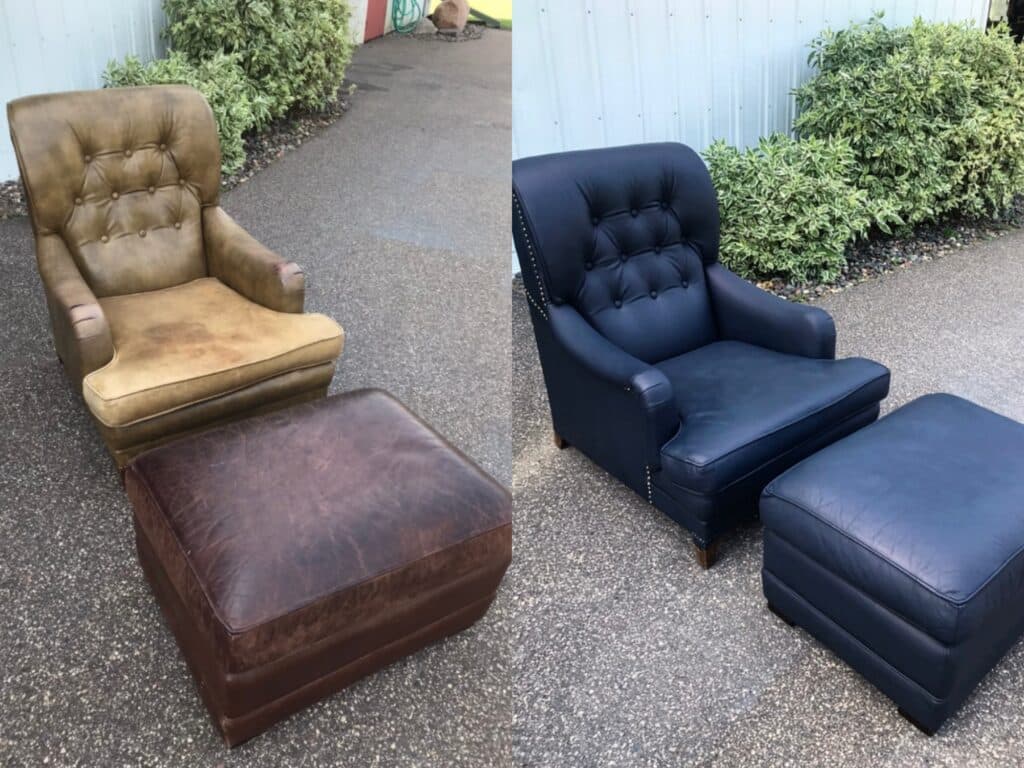
Here’s how to spot the finest quality leather:
We love aniline and semi-aniline leather (top grain or full grain leather that has been dyed but has little or no clear finish). This makes them absorbent, which also makes them susceptible to stains and fading. It also means they can be found for cheap, often free.
Their absorbency also makes them the best candidate for a change of color, so even if you find one in the wrong shade, you can transform it to suit your décor.
Look for these features:
- Removable cushions – These require more yardage and labor. If the cushions unzip, the interior stuffing can be cleaned, plumped up or replaced. Note that most recliner chairs and sofas do not have removable cushions, but many are still a decent quality finished (non-absorbent) leather.
- Stains – Absorbent leathers with little or no clear finish will easily stain. Water marks, body oil, and pet stains may permanently stain leather, but they can usually be cleaned and concealed with a new color.
- Sun fading – Absorbent leathers often show severe and uneven fading. The dyes used in these leathers are not as UV resistant as synthetic materials, and it will be obvious.
- Marbling – Look for variation in color along with absorbency. Many fake and real leather will have a ‘base-and-print’ or two-tone appearance, but they will also repel water.
- Suede backing – The backside of the material (or areas exposed by cracks or tears) will be real suede, not microfiber or a woven fabric.
Don’t be deterred by cat scratches or a hole! These can be repaired.
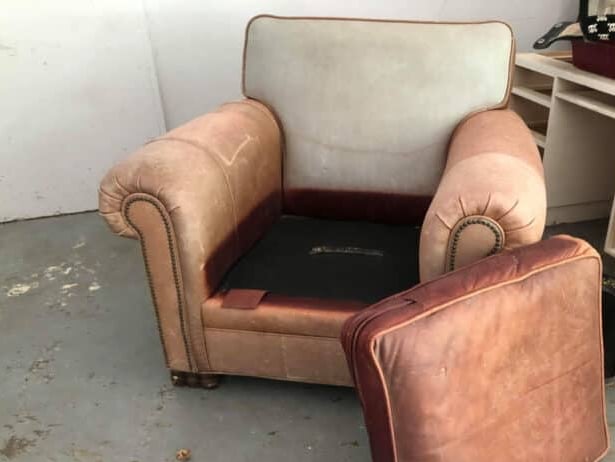
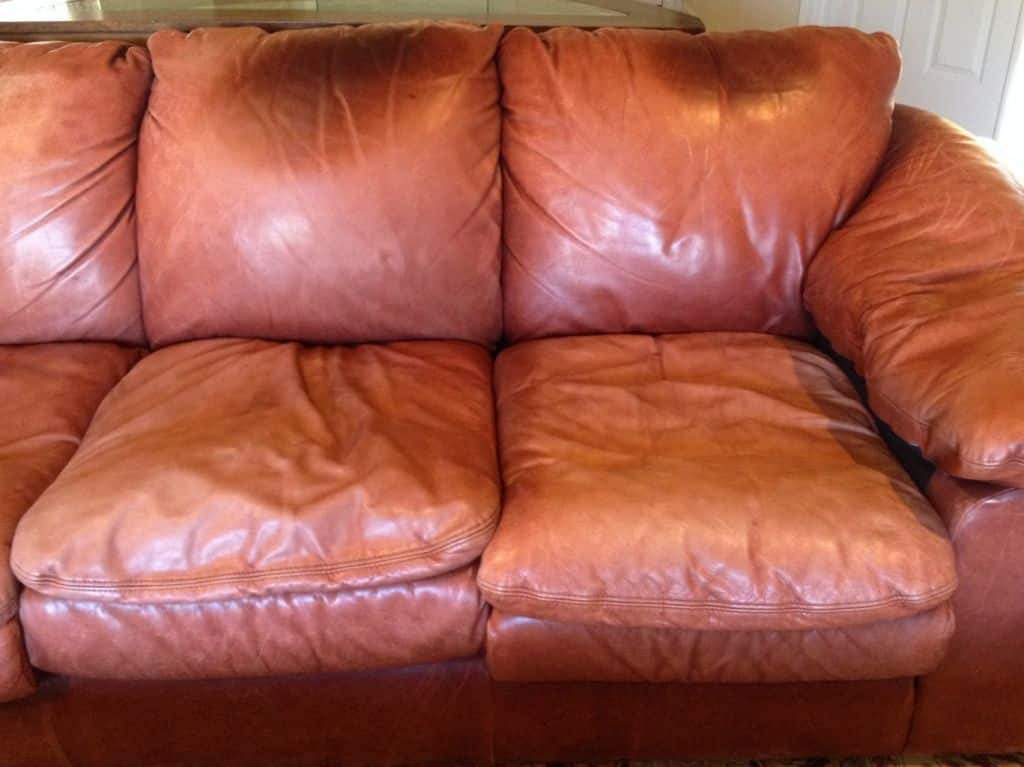
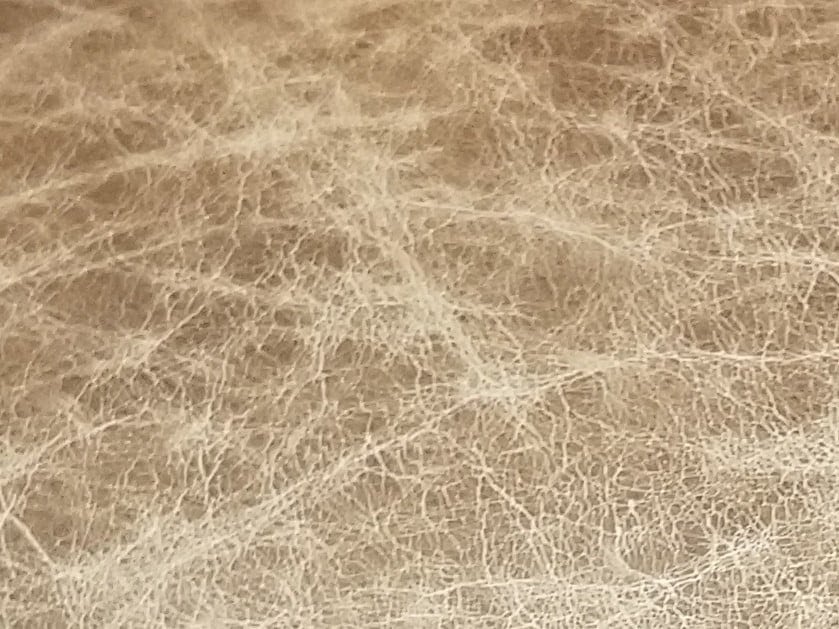
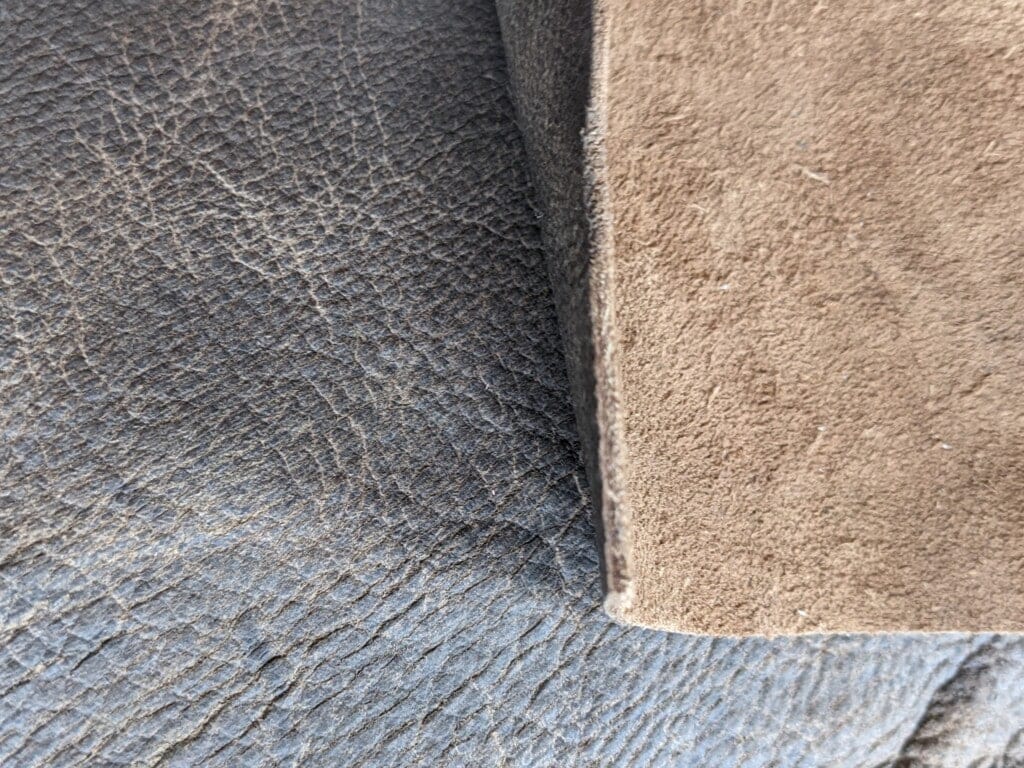
Also, don’t be fooled by some kinds of faux leather. As the smooth surface becomes worn, microfiber is exposed. It has a nap like real suede or carpet that can be brushed in any direction. These types of faux leather can be stained and coated with clear wax, but they are still poorer quality and not recommended.
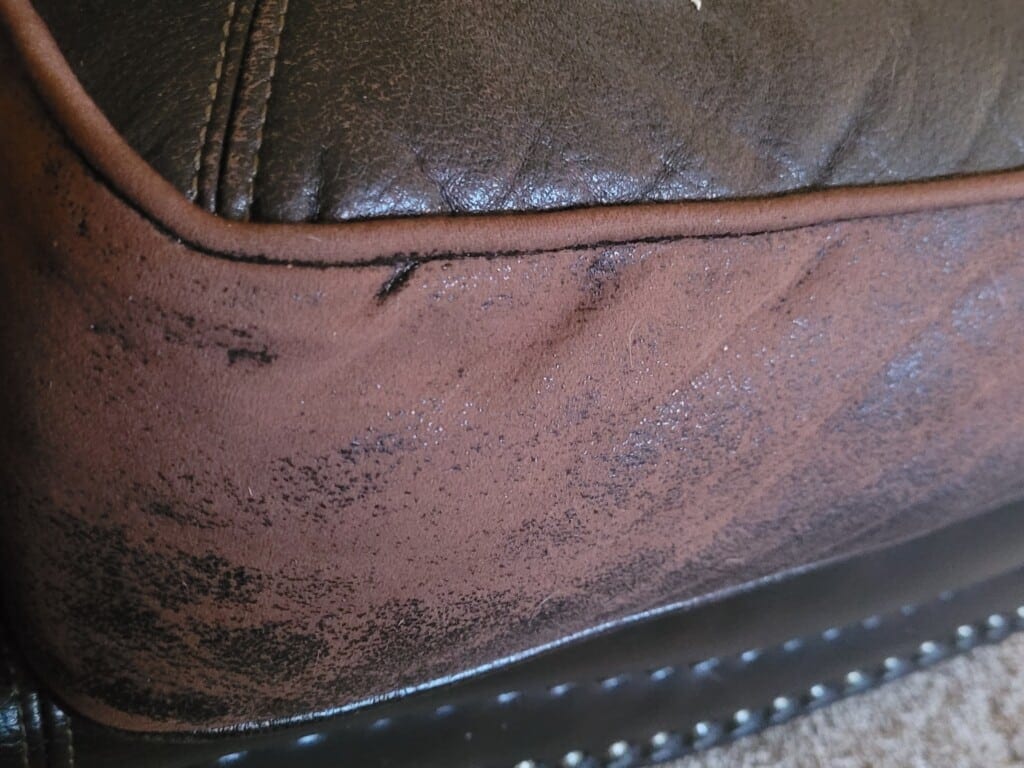
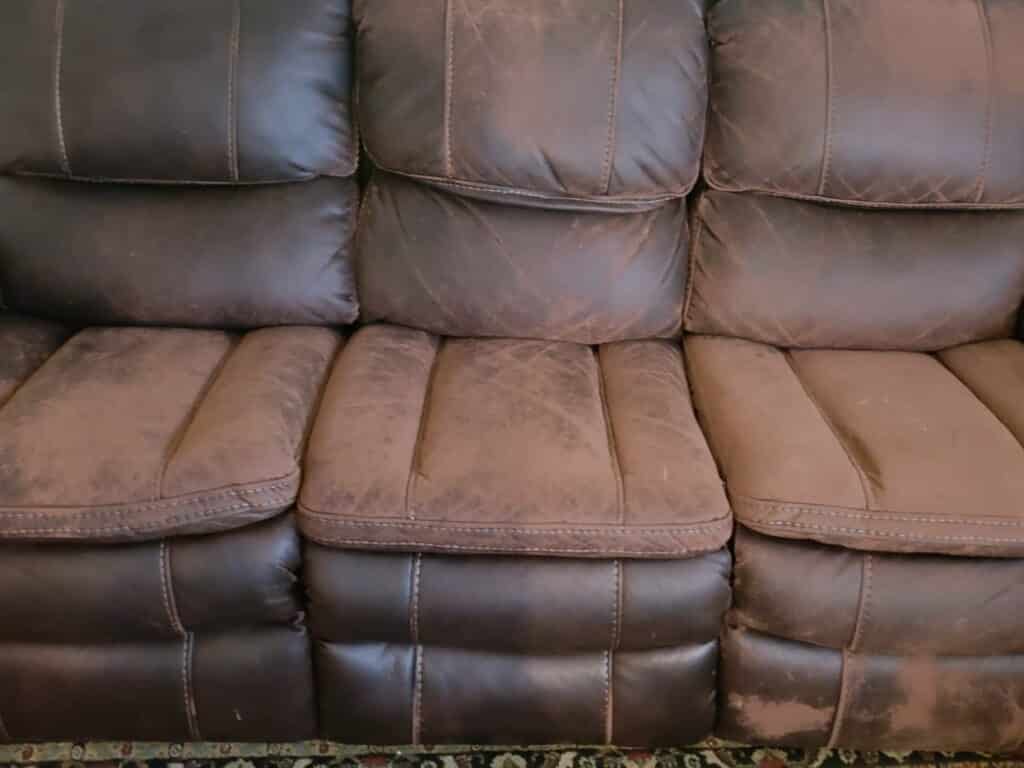
Learn more about the types of the leather as well as the differences between dyes and finishes.
If you need help, submit photos and request a consultation from the gal in the videos.
By now folks should know that bonded leather is Chinese trash that should be banned from being imported into the USA
They don’t. We get phone calls and emails every day, which is why we wrote this blog post to assist in answering these inquiries. Planning to make a video and hopefully optimize it for Google search results to put an end to these inquiries entirely.
I Wana post a picture of my couch I will not buy another bonded leather couch when I bought I truly believed I was buying a leather couch I love the red tho and leather we are mess ppl and it’s nice to wipe clean the couch.
Bummer! There’s no reason for bonded leather. Genuine leather and other synthetics (vinyl) wipe up nicely too. Leather does have a propensity for discoloring and grabbing dirt over time. Rubbing alcohol or our Flite cleaner (maybe a soft nail brush too) will greatly aid in this. Whatever stains remain can be dyed.
I bought a bonded leather chair from Johnny Janosik in Dover, DE. I was lied to and made to believe it was real leather. Also, it was a power recliner but the motor broke in less than two years. It cost $100 to get another motor and have it installed. I will never buy anything from Johnny Janosik again. I’ve only bought something twice from them. Several years ago I bought a bed. I didn’t want it delivered before such and such a time because it was a surprise. Wouldn’t you know it, they didn’t follow directions and delivered it much earlier and the person was home. I’m sure most people have had good luck with Johnny Jonosik in Dover or else they would not be in business, but I find them to be a great disappointment and would never recommend them. Each time my bonded leather chair starts to rip, I cover the rip with duct tape. It started to rip after three years.
I wire brushed the furniture to get the maximum fake leather off. Then I painted with acrylic paint mixed with fabric medium. Came out just fine for the family room.
Can I see a picture and how much time did the process take you?
what is fabric medium?
Right on! We’ve heard of some folks doing this. It’s an affordable solution if you’re willing to invest the time. How many hours did it take you? I can image it to be painstaking work, depending how unstable the polyurethane coating is, and in the end you have a fabric sofa that’s painted, not a piece with leather or leather-like surface. Thanks for sharing!
I have a 10 yr old Paliser bonded leather set that is starting to show fading and very light cracking on the top of the cushions ottoman by the seems. Am I able to re-color it as long as it isn’t peeling?
Great question! Yes, but the paint is not going to repair the cracks, and I wouldn’t recommend a color change, because then you’re adding more layers of paint (and therefore) weight to the surface, which *may* cause it to wear faster. That being said, ten years with only a few cracks is good news for a bonded leather, so it’s certainly worth a try. I don’t think it would worsen the situation, but I would ensure this by being minimalist and conservative in your approach.
Can a badly peeling bonded leather love seat/duo-recliner be reupholstered? I mean, not with more leather or vinyl…can fabric be put on? How costly would it be if it is do-able?
Reupholstery is expensive, especially if the cushions aren’t removable and therefore more easily accessible, which is a hallmark of bonded leather furniture. In the end, it’s cheaper to find a used piece of leather furniture (worth thousands more) and restore it. Or scrape away all the polyurethane surface and just live with the fabric substrate as this gentleman demonstrates.
what is he painting it with?
Some sort of “elastic” paint. For example LeakSeal or Rustoleum’s FlexSeal followed by their FinishAll paint. Question is what does it look like after another 18 months of use? Not to mention you’ll be huffing a lot more chemicals in these processes. But if the piece appears to be well made (despite the bonded leather), it may be worth it.
We bought two Flexsteel motorized Novu leather loveseats from a local store. Paid $2000 a piece for them. Approximately 1yr. later they started to peel. They made a repair. Next year more peeling in another area, they made another repair. When they came back to mount the seat they repaired they laid the whole love seat forward. Within one month the areas on the top of the arm and the front of the armrest are cracking and peeling from being pressed against the carpeting. We reported this to them, waited 2 months and contacted them again. They gave a lame excuse about contacting the company and 2 months later we haven’t heard back form them. NEVER, EVER, buy this shit again. Now we got $4000 of furniture with one piece looking like crap!!!! When they both eventually look like crap I’ll check into having the re-upholstered with material.
Hi James, So sorry to hear of this! We used to encounter a lot of this expensive “ultraleather” made by Flexsteel for the RV industry. It cost almost as much as real stuff and couldn’t hold up to use or UV exposure. Thank you for sharing your woes. Would love to have this same comment appear on our YouTube video about this subject, if you are so inclined. We can’t formally recommend that you illegally dump this trash in the parking lot of the retailer that sold it to you with a nasty gram attached, but we like to fantasize about it. 🙂 Be patient, and watch Craigslist! You’ll find a gem!
That red sofa looks exactly like the brown sectional we just moved to the curb after just 3 years of use. Loved the size & sit, but once it started delaminating, there was no stopping it! Unfortunately, the store where we bought it (actually a very reputable local furniture store) has closed because the owners retired & couldn’t find anyone to take it on. I suppose it’s no coincidence that the piece has absolutely no manufacturer’s ID on it that we can find.
Live & learn!
My imitation-leather couch is flaking just like these, to reveal a fabric layer below. But I don’t mind the patchy, worn-out look — I only mind the messy flakes that end up all over the floor and us. So I’m not looking to repair the damage, but is there anyway to prevent it from flaking more, perhaps sealing it with a varnish or something along those lines?
Thanks,
Jack
Hi Jack, It’s fabric, so your option is to painstakingly strip off the polyurethane coating and then coat it with a flexible paint. What a huge investment of time! It’s so much easier (and a nicer result) to find a used leather sofa on Craigslist or Facebook Marketplace and restore that. See this video:
https://youtu.be/w7ZUz6dT8Q4
Cindy Crawford, may be pretty, but she sure is endorsing some shady furniture makers with her name. I bought this Cindy Crawford ” Solid Leather ” recliner from ” Rooms to Go ” just at one year ago this month. I purchased the extra treatment and warranty . So after one year this “Solid leather” chair is pealing. ( by the way only the actual seating area of the chair is leather, the sides and back are Vinyl )
That actually isn’t all that uncommon. This does appear to be the seating area. Can’t quite tell if it’s a corrected grain leather or vinyl, but it doesn’t look like telltale peeling bonded leather. Many leathers have pigmentation that rubs away or discolors. So long as you can’t feel any difference between the discolored and the original, it can be quickly corrected with some Rub ‘n Restore leather dye! The trick is matching the color. More info here: https://rubnrestore.com//product-category/color-matching-services/